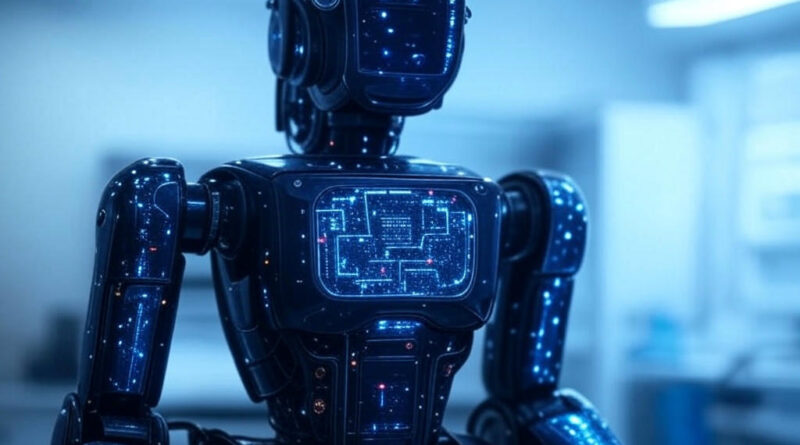How Reinforcement Learning Is Powering Robotics in 2025
In 2025, one of the most exciting developments in artificial intelligence is how reinforcement learning is powering robotics. Robots are no longer just mechanical arms on assembly lines—they’re becoming autonomous agents that learn, adapt, and even self-correct in real-time. From warehouse automation to surgical assistance, reinforcement learning (RL) is transforming how robots think and operate.
What Is Reinforcement Learning?
Reinforcement learning is a type of machine learning where an agent learns to make decisions by interacting with its environment. It’s modeled around the concept of rewards and punishments—the agent receives feedback and adjusts its actions to maximize cumulative reward over time.
Unlike supervised learning, RL doesn’t rely on labeled data. Instead, the system learns from experience, just like humans. This makes it a perfect match for robotics, where real-time decisions and continuous improvement are crucial.
How Reinforcement Learning Is Powering Robotics in 2025
In 2025, reinforcement learning is at the heart of robotic autonomy. Here’s how:
1. Autonomous Navigation
Self-driving delivery robots and drones use RL algorithms to adapt to changing environments, avoid obstacles, and optimize routes—all without human intervention.
2. Dexterous Manipulation
From picking up delicate objects to assembling complex machinery, robotic arms now leverage deep reinforcement learning to handle uncertainty and perform fine motor tasks with human-like precision.
3. Personalized Interactions
Service robots in healthcare and hospitality are using RL to learn human preferences, adapt to emotions, and deliver personalized experiences, improving both efficiency and empathy.
4. Real-Time Learning
Modern RL frameworks allow robots to learn on-the-fly, adjusting behaviors in real-time rather than relying solely on pre-programmed actions.
These advancements have made it clear: reinforcement learning is powering robotics in 2025 like never before.
Real-World Applications of RL in Robotics
Let’s look at where RL-powered robotics is making a real impact:
Industrial Automation
Companies like Boston Dynamics and NVIDIA are using RL to train robots that move autonomously in factories, identifying parts and adjusting for wear and tear without needing explicit reprogramming.
Medical Robotics
Robotic surgery assistants use RL to optimize procedures, reduce error rates, and even predict patient outcomes.
Smart Home Robots
AI-powered home assistants can now vacuum, cook, and even fold laundry—thanks to RL algorithms that allow continuous learning and adaptability in complex environments.
Logistics & Warehousing
Amazon and FedEx deploy RL-based robots that coordinate with each other, maximizing efficiency in high-demand situations like holiday seasons.
Challenges and Limitations
While the growth is impressive, there are still challenges:
- Data Efficiency: RL often needs massive amounts of training data.
- Safety Concerns: RL agents can sometimes take risky actions in exploration.
- Real-World Transferability: Policies learned in simulations don’t always work perfectly in the real world (the “sim2real” gap).
Researchers are actively working on solutions such as safe RL, offline RL, and multi-agent systems to bridge these gaps.
What’s Next for RL-Powered Robots?
The future looks incredibly promising:
- Explainable AI (XAI) will make robotic decisions more transparent.
- Federated Learning could allow robots to share knowledge without data centralization.
- Human-Robot Collaboration will get more seamless, enabling co-working and even emotional bonding.
The next leap? Fully autonomous general-purpose robots that learn across domains—from assisting in surgeries to performing disaster recovery missions.
Frequently Asked Questions (FAQ)
How is reinforcement learning different from traditional AI in robotics?
Reinforcement learning allows robots to learn from their own actions instead of relying on predefined rules. This enables autonomy and adaptability, unlike traditional rule-based systems.
Is reinforcement learning safe for real-world robotics?
While there are risks in uncontrolled learning environments, modern RL research focuses heavily on safe exploration and risk-averse policies to ensure safety in deployment.
Which industries benefit the most from RL-powered robotics?
Industries like healthcare, logistics, manufacturing, and retail are already seeing major gains from RL integration in robotics.
What tools are used to build RL-powered robots?
Popular RL frameworks include OpenAI Gym, Stable Baselines3, and RLlib. They often integrate with robotic platforms like ROS (Robot Operating System).
Can small businesses use RL-powered robots?
Yes! With cloud-based robotics platforms and affordable hardware, even small startups can adopt RL-driven automation in 2025.
Conclusion
As we move deeper into 2025, it’s evident that reinforcement learning is powering robotics to new heights. From precise industrial bots to empathetic service robots, RL enables machines to go beyond programmed instructions—they learn, evolve, and think.
Whether you’re a tech enthusiast, a business owner, or a developer, the age of intelligent robotics is here—and reinforcement learning is leading the charge.
Want to Dive into Other Trending Tech Topics in 2025?
Explore more of our expert-written guides and insights:
- How to Create a Smart Contract on Ethereum: Step-by-Step Guide – A beginner-friendly tutorial to launch your first smart contract.
- GitHub Actions vs. Jenkins for Beginners: What to Use in 2025? – Discover which CI/CD tool is right for your next project.
- How Blockchain is Revolutionizing Supply Chain Management in 2025 – Understand the game-changing role of blockchain in logistics.
Helpful Resources to Explore Further
- OpenAI – Reinforcement Learning Explained – A great place to explore foundational research and applications of RL.
- DeepMind – Reinforcement Learning Research – From the creators of AlphaGo and AlphaStar, this offers cutting-edge RL research applied in real-world robotics and games.

